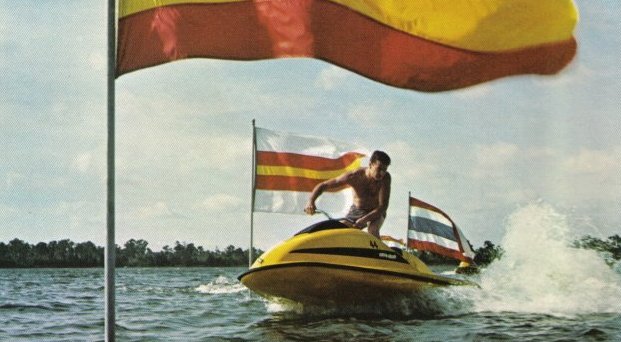

1968 & 69 Model 320
Bombardier releases the '68 Model 320 to the unsuspecting masses after a relatively short development period. Pictures being worth a thousand words, I shall let the accompanying scans speak for themselves.
The initlal '68 release used a multiple v-belt pump drive arrangement that would slip when it got wet or loose. These were subsequently upgraded to the timing belt system that was standard on the '69 320.
The original '68 rear hood design hinged from two brackets below the rub rail and had a tendency to admit excessive water into the hull. The '68s were upgraded to the '69 design which moved the hinge point above the rub rail and used a piano hinge instead of the brackets. Larger air vents were also a much needed feature of the '69 hood.
The upgrade of the '68 model to '69 spec was done under a no-charge recall campaign. The customer was given the option of receiving the upgrade or exchanging for a '69 320 Olympique or '69 372 Sea-doo (straight trade).
The returned 320's were salvaged of gas tanks, cables cut, turned upside down and engines and pumps cut out with the related section of hull. The engine & pump combo's were put on skids and made available for sale through regular parts channels. Hull remnants were subsequently crushed and trashed.
Anyway, the '69 320 improvements helped some but problems still arose in spades...chronic vapor lock, broken pump shafts due to overtightened belt, engine water ingestion (apparently the timing belt could act as a conveyor if there was excess water in the hull and fire it right into the flame arrestor). Shallow water operation or running up on the beach, as promoted in the sales brochures & video of the day, typically resulted in foreign material plugging the exhaust cooling pump fitting and resulting in a melted cooling hose.
If none of the above got you there was always the chance of explosion. Hull vibrations would loosen fasteners and connections with random sparks igniting fuel vapors if in the right concentration. Apparently one of the worst ideas was to try to diagnose a no start by pulling the plug(s) and checking for spark without allowing time for ventilation.
Bombardier releases the somewhat better Model 372